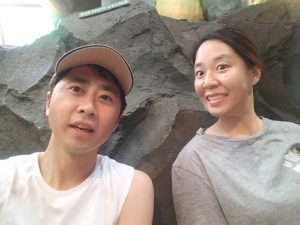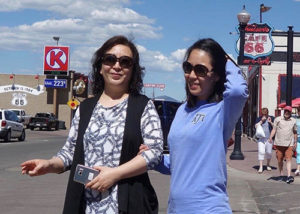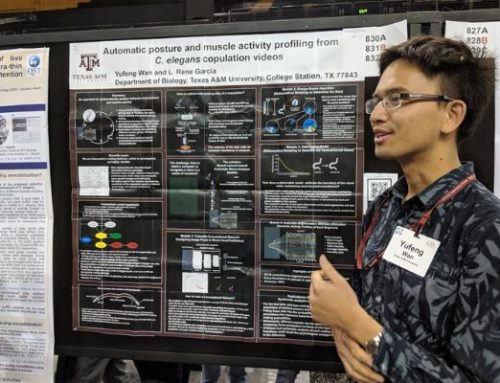Graduate Student Spotlight, Kyoungsun Rha
This month’s Graduate Student Spotlight highlights Kyoungsun Rha. A student in the Garcia Lab, Kyoungsun works on identifying the mechanism of how cells regulate their metabolisms to maintain their functionality. Learn more about Kyoungsun and her graduate experience in this month’s Spotlight below.

Kyoungsun Rha
I am sixth year Ph.D student in Dr. Garcia’s lab. I received my B.A. in Biology from University of Utah in Salt Lake City, Utah. During my undergraduate I was working at Dr. Alan Light’s lab, focusing on neurobiological pathway of pain mechanism. My research focused on identifying and characterizing the molecular receptors present on, and that differentiate the various populations of cells within the dorsal root ganglion. From the undergraduate lab experience, I earned great interests in research, and decided to pursue further degree in biology. Then, I joined the Ph.D program in Biology, Texas A&M University at 2014.
I first joined Dr. Harlow’s lab, and worked on a project identifying the functional roles of the newly discovered orphan carrier protein in nervous system of mammals. This protein turned out to be playing roles in mitochondrial metabolisms. However, due to limitations associating with mouse model, I moved to Dr. Garcia’s lab to continue my research on a new model organism, C. elegans. Since then, I am focusing on identifying the mechanism of how cells regulate their metabolisms to maintain their functionality.


What is on your bookshelf?
Most of the books on my physical bookshelf are academic. I have several old textbooks that I still use for teaching and for my research, also some old class materials such as presentation slides, class notes etc. Besides those I have some old novels that were required to read in high school literature class. On my Ebook shelf, I have all series of Harry Potter, including audio books that I can hear while doing the benchwork. The rest of it is mostly fictions and fantasy. I like the books that make me imagine and draw pictures of the scene in my head while I am reading.
What advice would you give to new/incoming students?
When you rotate, try to find somewhere you’d like to spend most of your day rather than focusing too much on the research subject. Look for your future colleagues’ and PI’s personality, if you get along with them too. If you like the people around you, interests in research will follow.
Also, you don’t need that heavy coat in College Station.
What is one thing people would be surprised to know about you?
I came to the States alone when I was 17 years old. I was an exchange student, and after that I continued my education in the States.
What do you think are your greatest strengths as a TA?
Besides helping them to get through the course, my other goal for teaching is helping them to enjoy the class and the subject itself. If they like and are enjoying the course, they will be self-motivated, also the stuff they learned from the class will remain afterward. I do my best to make the class environment enjoyable as much as possible.
What characteristics do you prize most in a colleague?
The ability to provide a good explanation is what I prize the most. I think the most important thing in this profession is how well we can provide a good explanation about new findings and emphasize the importance of it.
Why did you choose to focus on metabolism?
I was more interested in neuroscience rather than metabolism when I first joined the department. After I joined Dr. Harlow’s lab, I started to work on the project identifying the role of the orphan protein in bile acid co-transporter family. This protein was known to be expressed in synaptic vesicles from a published paper. However, we found it does not express in the synaptic vesicles, and seemed to function in metabolic pathways. Since then my interest has shifted toward metabolism.
What projects are you currently working on?
Metabolic syndrome, a broad clinical term defined by a cluster of risk factors, increases the risk for cardiac, and neurodegenerative diseases including Alzheimer’s and Parkinson’s disease. Under stress conditions, such as low levels of oxygen, energetic tissue can readily switch to glycolytic metabolism, a flexibility that is compromised in metabolic syndrome. Any disruption of this tightly coupled respiration can result in overproduction of reactive oxygen species (ROS), which can lead to cell apoptosis.
With Dr. Harlow, we discovered an orphaned bile acid carrier protein that is highly conserved in mammals. Knocking out this protein in cardiac mitochondria resulted disrupted respiration including increased ROS production. I was working to find the location of this protein in the cardiac mitochondria and examine in detail the metabolic pathway this protein participates in mouse model. However, due to unspecificity of the antibody and the complexity of the model organism there was some limitations to continue this project on mouse model. Recently I moved to Dr. Garcia’s lab to continue my research on new model organism, C. elegans which provide more genetic tools. My long-term research goal is to understand how energetic cells regulate and maintain their tightly coupled metabolism.








